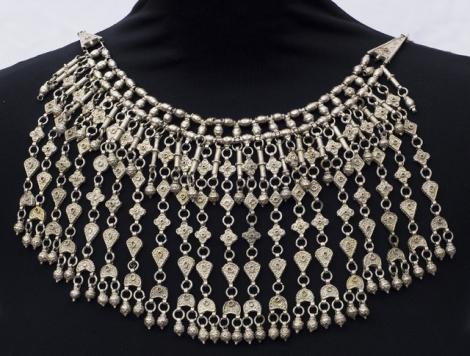Pearl Necklace
Maʻaneqat Lūlū
Pearl Necklace
The Pearl Necklace was one of the more splendid items of jewellery worn by the Jewish bride of Ṣanʻā’. It consisted mostly of silver and silver-gilt (vermeil) ornamentation, but was called in the Arabic vernacular, tašbūk lūlū, on account of its pearls, which were the most prominent feature among the head decorations: A high crown of pearls was borne upon the forehead of the bride, strings of pearls with pendants at her temples – suspended from the two sides of her face, and finally the gilded labbeh necklace and the pearl necklace covered withal her chin, concealing her neck. All of these created just the right touch and finesse, giving to the bride’s countenance uniqueness when compared to her neighbour, the Muslim bride, while the whiteness of the shining pearls upon her forehead alludes to her innocence. Pearl necklaces were a rarity in Yemen, but the few examples which are known in Israel are designed with a style characteristic of Jewish maʻaneqah necklaces (strings of pearls hanging between two borderline triangles). In this case, the one shown here happens to be the only version of its kind: strings of bound pearls, alternating between beads of gilt silver – similar to the ʻaqid mirğān, the Muslim coral necklace. This necklace and the set of necklaces worn above the chest by Jewish brides were part of the repertoire of necklaces worn by Muslim women from Ṣanʻā’. Contrary to the rigid rules of practice in Ṣanʻā’, requiring that a distinction be made in dress codes and accoutrements worn by Jews and those worn by Muslims, during interim periods – such as after childbirth or during weddings, which were seen as precarious times from the woman’s perspective – children and brides donned them because of the magical powers ascribed to them.




